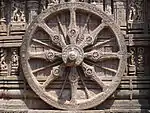Eastern Ganga dynasty
The Eastern Ganga dynasty also known as Rudhi Gangas or Prachya Gangas were a medieval Indian dynasty that reigned from Kalinga from as early as the 5th century to the early 15th century. The territory ruled by the dynasty consisted of the whole of the modern-day Indian state of Odisha as well as parts of Andhra Pradesh and Chhattisgarh.[2] The early rulers of the dynasty ruled from Dantapura; the capital was later moved to Kalinganagara (modern Mukhalingam), and ultimately to Kataka (modern Cuttack).[3] Today, they are most remembered as the builders of the world renowned Puri Jagannath Temple and Konark Sun Temple, a UNESCO World Heritage site at Konark, Odisha.
Eastern Ganga Empire | |||||||||||
|---|---|---|---|---|---|---|---|---|---|---|---|
| 1038 CE–1434 CE | |||||||||||
| Capital | Dantapura Kalinganagara Kataka | ||||||||||
| Common languages | Odia[1] | ||||||||||
| Religion | Hinduism | ||||||||||
| Government | Monarchy | ||||||||||
| Tri-Kalingadhipati | |||||||||||
• 980–1015 | Vajrahasta Aniyankhabhima | ||||||||||
• 1038–1070 | Vajrahasta Anantavarman | ||||||||||
• 1070–1078 | Rajaraja Devendravarman | ||||||||||
• 1078–1147 | Anantavarman Chodagangadeva | ||||||||||
• 1178–1198 | Ananga Bhima Deva II | ||||||||||
• 1238–1264 | Narasingha Deva I | ||||||||||
• 1414–1434 | Bhanu Deva IV | ||||||||||
| Historical era | Classical India | ||||||||||
• Established | 1038 CE | ||||||||||
• Disestablished | 1434 CE | ||||||||||
| |||||||||||

The rulers of Eastern Ganga dynasty defended their kingdom from the constant attacks of the Muslim rulers. This kingdom prospered through trade and commerce and the wealth was mostly used in the construction of temples. The rule of the dynasty came to an end under the reign of King Bhanudeva IV (1414–34), in the early 15th century.[4] Their currency was called Ganga fanams and was similar to that of the Cholas and Eastern Chalukyas of southern India.[5]
Origin
The origin of the Later Eastern Gangas is not clearly established.[6] It is erratically summarized that they were an offshoot of the Western Ganga dynasty who were a south Indian dynasty but there is no evidence of architectural, linguistic and patterns of nomenclature of the kings having similarity between the Ganga kings of Karnataka and that of Odisha.[7] Also, while the bardic traditions of the Western Ganga dynasty claim descent from the Sun through the Ikshavaku dynasty, the Eastern Ganga genealogies ascribe descent from the Moon; the Chandravamsa lineage. Unlike the Western Ganga Dynasty who traced their lineage to the Solar Dynasty,[8] the Later Eastern Gangas claimed a lunar descent from Vishnu through Brahma, Atri and Chandra (moon).[9] The Eastern Ganga king Indravarman III in his Andhavaram copperplate inscription has mentioned that the Gangas are described as the descendants of the Tumbura dynasty. In the Vayu Purana references are made that at the foothills of the Vindhyas, there was a Janapada named Tumura, Tumbura. Odia historian Jagabandhu Singh citing references from Padma Purana and Brahmavaibarta Purana has identified Tumbura being ruled by the Mahisya race of Khshetriyas who were maritally either related to the Kaivartta community or were born from marriages between Khsetriyas and Vaishya women.
Five prominent dominions of the Kalingan Prachya Ganga family are identified from five different administrative centers namely - Kalinganagara (Srikakulam), Svetaka Mandala (Ganjam), Giri Kalinga (Simhapur), Ambabadi Mandala (Gunupur, Rayagada) and Vartanni Mandala (Hinjilikatu, Ganjam) . The heartland of the Prachya Gangas had three parts of Kalinga namely, Daksina Kalinga (Pithapura), Madhya Kalinga (Yellamanchili Kalinga or Visakhapatnam) and Uttara Kalinga (districts of Srikakulam, Ganjam, Gajapati and Rayagada). The earliest known prominent king was Indravarman who is known from his Jiringi copper plate grant. The Godavari grant of Raja Prthivimalla and the Ramatirtham grant of Vishnukundina king Indrbhattaraka refer to a war of four tusked elephants or Chaturdanta Samara in which Indravarman I the son of Mitavarman, a Ganga general of Vakataka king and a local ruler of Dantapura commanded an alliance of small South Kalingan kingdoms against the powerful Vishnukundina king Indrabhattaraka, defeated and killed him.[10] The Vishnukundins returned with a vengeance, defeated the Vakataka King and members of the alliance while Indravarman declared himself as Tri-Kalingadhipati (the lord of the three Kalingas) rising from obscurity and moving his capital northwards away from the attacking Vishnukundins. His son Hastivarman found himself stuck between two Gupta feudal dynasties of Odisha, the Vigrahas of South Toshali and Mudgalas. Joining the onslaught like his father, he commanded major battles against the Vigrahas and won territories in the northern parts of ancient Kalinga and declared himself as Sakala-Kalingadhipati (the ruler of whole Kalinga). The dynasty though remaining to be a strong ruling family in ancient Odisha and North Andhra Pradesh continued to remain as vassal rulers under the central authority of the Bhauma-Kara dynasty which is proven by the fact that a smaller Eastern Ganga king belonging to the clan and named as Jayavarmadeva mentioned himself as the vassal of Sivakara Deva I in his Ganjam grant and by whose permission he gave away the grants.
It was during the rule of Anantavarman Vajrahasta V in the mid eleventh century that the clan started emerging as a major military power challenging the authority of the Somavanshi Dynasty at their northern frontiers and allying with their arch rivals the Kalchuris. After a series of victories in battle and making land grants to three hundred Brahmin families in his kingdom, Vajrahasta V assumed the titles as Trikalingadhipati (lord of the three Kalingas) and Sakalakalingadhipati (lord of complete Kalinga) challenging the centralized authority of the Somavanshis and laying the foundation to an imperial era for the Eastern Gangas. In the later years of the century, Devendravarman Rajaraja I defeated the Somavanshi king Mahasivagupta Janmenjaya II completely while challenging the Cholas in battle, along with establishing authority in the Vengi region. The Cholas were defeated by Rajaraja I and Chola princess, Rajasundari, was married off to the Eastern Ganga king as a goodwill gesture for settlement of affairs between the Cholas and the Gangas.[11] The identification of the father of Rajasundari is a matter of great controversy and some scholars like K. A. Nilakanta Sastri identify the king as Virarajendra Chola.[12][13] After the sudden death of Rajaraja I, his underage sons Chodaganga Deva ascended the throne, losing the many parts of his ancestral kingdom to the Cholas who were now in an advantageous position. However, Ananatavarman Chodaganga Deva not only lived a young life of prolonged struggles and setbacks but finally managed to completely rout the Chola presence from the region and finally securing Utkala, Kalinga, Gauda, Radha and Vengi as one kingdom. While many of his inscriptions are found inside the limits of former Vengi kingdom, this large extent of his empire from Bengal to Vengi is clearly stated in his Korni grant inscriptions.[14][15] In the Sri Kurmam temple grant of Chodaganga, it is clearly stated that he has extended his territory from Bhagirathi Ganga to Gautami Ganga rivers which literally the region between river Ganga and Godavari.[16] The only front where he faced setbacks is against his western rivals the Kalachuris where he was unsuccessful. His descendant Anangabhima Deva III gradually completed the task of defeating the Kalachuris completely. In his Korni copper plate grant he mentions himself to be the lord of 99,000 war elephants which while counting military strength according to the ancient Gulma system of military divisions, puts his strength to a million men and half a million animals employed to his command. Due to his maternal relation with the Cholas, a Chola uncle of Chodaganga by the name Virachoda had sided by him as a protective guardian against the invading Cholas since his childhood. Chodaganga was married to the daughter of this uncle and also had Tamil officers serving him during his lifelong affairs of war and administration.[17] Chodaganga Deva not only reunited most of ancient Kalinga stretching from the rivers Ganga to Godavari but led the foundation to the imperial hegemony of the Eastern Gangas in the Eastern coast of India. Chodaganga Deva was a strong king and was the son of Rajaraja Devendravarman and grandson of Vajrahasta Anantavarman of the Imperial Gangas of Kalinganagara.[18][19][20] His mother was princess Rajasundari of the Chola dynasty.[21]
Background
After the fall of Mahameghavahana dynasty, Kalinga was divided into different kingdoms under feudatory chiefs. Each of these chiefs bore the title Kalingadhipathi (Lord of Kalinga). The beginnings of what became the Eastern Ganga dynasty came about when Indravarma I defeated the Vishnukundin king, Indrabhattaraka and established his rule over the region with Kalinganagara (or Mukhalingam) as his capital, and Dantapura as a secondary capital. The Ganga kings assumed various titles viz. Trikalingadhipathi or Sakala Kalingadhipathi (Lord of three Kalinga or all three Kalingas namely Kalinga proper (South), Utkala (North), and Kosala (West)).
Mukhalingam near Srikakulam of Andhra Pradesh bordering Odisha has been identified as Kalinganagara, the capital of the early Eastern Gangas.[22]
After the decline of the early Eastern Gangas reign, the Chalukyas of Vengi took control of the region. The first monarch of the dynasty Vajrahastha Aniyakabhima I (980-1015 A.D), took advantage of the internal strife and revived the power of the Ganga dynasty. It was during their rule that Shaivism took precedence over Buddhism and Jainism. The magnificent Srimukhalingam Temple at Mukhalingam was built during this period.
In the 11th century, the Cholas brought the Ganga Kingdom under their rule with the sudden death of Devendravarman Rajraja I.[22] His son Chodaganga Deva who ascended the throne at the age of five under the protection provide by one of his maternal uncles from the Chola family had to overcome multiple obstacles before securing Kalinga, Vengi, Utkala, Odra and parts of Bengal as one kingdom.
Intermarriage
The Eastern Gangas were known to have intermarried with the Parmaras, Cholas, Chalukyas. The early state of the dynasty may have started from the early 8th century.
Anantavarman Chodaganga
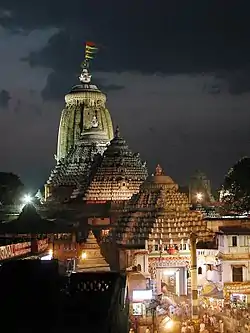
The dynasty, towards the end of eleventh century came to be known as Chodaganga dynasty after its founder Anantavarman Chodaganga. He was the son of Rajaraja Deva, the ruler of Kalinga kingdom centered around the region of Southern Odisha and northern Andhra coast, while his mother was the Chola princess, Rajasundari, daughter of the Chola emperor Virarajendra Chola.
He is believed to have ruled from the Ganges River in the north to the Godavari River in the south, thus laying the foundation of the Eastern Ganga Dynasty. Also during his rule, the great Jagannath Temple at Puri was built.[22] He assumed the title of Trikalingadhipathi (ruler of the three Kalingas which comprise Kalinga proper, Utkala north and Koshala west) in 1076 CE, resulting in him being the first to rule all three divisions of Kalinga.[23]
Anantavarman was a religious person as well as a patron of art and literature. He is credited for having built the famous Jagannath Temple of Puri in Odisha.[23] King Anantavarman Chodagangadeva was succeeded by a long line of illustrious rulers such as Narasingha Deva I (1238–1264).
Intrudes
Rajaraja III ascended the throne in 1198 and did nothing to resist the Muslims of Bengal, who invaded Orissa in 1206. Rajaraja's son Anangabhima III, however, repulsed the Muslims and built the temple of Megheshvara at Bhuvaneshvara. Narasimhadeva I, the son of Anangabhima, invaded southern Bengal in 1243, defeated its Muslim ruler, captured the capital (Gauda), and built the Sun Temple at Konark to commemorate his victory. With the death of Narasimha in 1264, the Eastern Gangas began to decline; the sultan of Delhi, Firuz Shah Tughlaq, invaded Odisha in between 1353 and 1358, and levied tribute on the Ganga king.[24] The Musunuri Nayaks defeated the Odishan powers in 1356. Narasimha IV, the last known king of the Eastern Ganga dynasty, ruled until 1425. The "mad king," Bhanudeva IV, who succeeded him, left no inscriptions; his minister Kapilendra usurped the throne and founded the Suryavamsha dynasty in 1434–35.
Rulers
- Mittavarman, a vassal Eastern Ganga king under Vakataka rule (c. ?-?)
- Indravarman I (496–535)[22]
- Samantavarman (537-562)
- Hastivarman (562-578)
- Indravarman II (578-589)
- Danarnava (589-652)
- Indravarman III (589-652)
- Gunarnava (652-682)
- Devendravarman I (652-682?)
- Anantavarman III (808-812?)
- Rajendravarman II (812-840?)
- Devendravarman IV (893-?)
- Devendravarman V (885-895?)
- Gunamaharnava I (895-939?)
- Vajrahasta II (or Anangabhimadeva I) (895-939?)
- Gundama - (939-942)
- Kamarnava I (942-977)
- Vinayaditya (977-980)
- Vajrahasta Aniyakabhima (980-1015 AD)[25]
- Vajrahasta Anantavarman or Vajrahasta V (1038-?)
- Rajaraja Devendravarman or Rajaraja Deva I(?-1078)
- Anantavarman Chodaganga (1078–1150)[22]
- Jateswara Deva or Ekajata Deva (1147-1156)
- Raghava Deva (1156-1170)
- Rajaraja Deva II (1170-1178)
- Ananga Bhima Deva II (1178–1198)
- Rajaraja Deva III (1198–1211)
- Ananga Bhima Deva III (1211–1238)
- Narasimha Deva I (1238–1264)[22]
- Bhanu Deva I (1264–1279)
- Narasimha Deva II (1279–1306)[22]
- Bhanu Deva II (1306–1328)
- Narasimha Deva III (1328–1352)
- Bhanu Deva III (1352–1378)
- Narasimha Deva IV (1379–1424)[22]
- Bhanu Deva IV (1424–1434)
Descendants
A branch of the Eastern Ganga dynasty survived as the kings of the Parlakhemundi state, currently part of the Gajapati district,Odisha. Scions of this line include,
- Jagannatha Gajapati Narayana Deo II (Reign: 1751 CE - 1771 CE)- who ascended to the throne at a time when Odisha was torn apart due conflicts between external powers like the Mughals, Marathas, French and British for control of the territory in 18th century.
- Krushna Chandra Gajapati (Reign as Maharaja of Paralakhemundi: 26 April 1913 - 25 May 1974)- who was a key personality and regarded as the architect of an Independent united Odisha State and went on to become the first Prime Minister of Orissa province formed in 1936. Prime Minister in office from 1 April 1937 to 19 July 1937 and 2nd time from 29 November 1941 to 29 June 1944. The present-day Gajapati District of Odisha which was earlier a part of the historic Ganjam district was named after him.[26][27][28]
- Gopinath Gajapati (Titular Maharaja: 25 May 1974 - 10 January 2020)- served as the member of the 9th and 10th Lok Sabha of India and represented the Berhampur constituency of Odisha.
- Kalyani Gajapati (Titular Maharani since 10 January 2020)- current head of the dynasty.[29][30]
Legacy
The Eastern Gangas were great patrons of religion and the arts, and the temples of the Ganga period rank among the masterpieces of Kalinga and Hindu architecture.[31]
Regnal year system (Anka year)
The Anka year (Odia: ଅଙ୍କ Aṅka) system is a unique regnal year system instituted by the kings of the Eastern Ganga dynasty for dating their reigns. It had a number of features that mark the regnal year different from that actual duration of the year elapsed during the reign. The system still survives today and is used in the Odia calendar (panjis) and the regnal year is marked by the titular reign of the current Gajapati Maharaja of Puri who belongs to the Bhoi dynasty.[32][33]
| Ruler | Reign | Regnal year duration | Anka year duration |
|---|---|---|---|
| Anantavarman Vajrahasta III | 1038-1070 | 32 | 41 |
| Rajaraja Devendravarman I | 1070-1078 | 8 | 11 |
| Anantavarman Chodaganga | 1078-1147 | 69 | 87 |
| Kamarnava II | 1147-1157 | 10 | 13 |
| Raghava | 1157-1170 | 13 | 17 |
| Rajaraja II | 1170-1190 | 20 | 25 |
| Anivankabhima II | 1190-1197 | 7 | 10 |
| Rajaraja III | 1197-1207 | 10 | 13 |
| Anangabhima Deva III | 1216-1235 | 19 | 24 |
| Narasingha Deva I | 1238-1263 | 26 | 33 |
| Bhanudeva I | 1264-1279 | 15 | 19 |
| Narasimhadeva II | 1279-1306 | 27 | 34 |
| Bhanudeva II | 1306-1328 | 22 | 28 |
| Narasimhadeva III | 1328-1352 | 24 | 31 |
| Bhanudeva III | 1352-1378 | 26 | 33 |
| Narasimhadeva IV | 1378-1414 | 36 | 45 |
| Bhanudeva IV | 1414-1434 | 20 | 25 |
Coinage
The Eastern Ganga coinage consisted of gold fanams. The obverse typically depicts a couchant bull along with other symbols. The reverse features a symbol which represents the letter sa (for samvat, which means year) flanked by elephant goads or an elephant goad with a battle axe, along with a number below, which depicts the regnal year(anka year) of the reigning monarch. Some coins also carry the legend śrī rāma on the reverse above the letter sa.
An interesting aspect of the Eastern Ganga coin dates is that these coins may be the earliest Hindu coins using decimal numbers for dating. Earlier dated coins, such as those of the Western Satraps, the Guptas etc, used the old Brahmic numbering system with separate symbols representing each of the single digits, separate symbols representing two-digit multiples of ten, such as 20, 30, 40, and so on, and further separate symbols representing three-digit numbers such as 100, 200, etc. Thus a number like 123 was written as 100-20-3. But the Eastern Ganga coins were written using the symbols for the single digits, with the position of the number indicating the value such as tens or hundreds, thus effectively using the Zero-place holder system.[32][33]
 Eastern Ganga coinage numerals
Eastern Ganga coinage numerals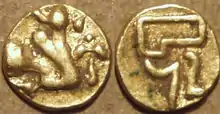 Eastern Ganga fanam of Anantavarman Chodaganga (Anka year 63- 1128 CE)
Eastern Ganga fanam of Anantavarman Chodaganga (Anka year 63- 1128 CE)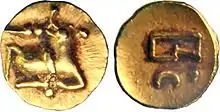 A Fanam (Coin) of Eastern Ganga Dynasty[34]
A Fanam (Coin) of Eastern Ganga Dynasty[34]
Gallery
| Outline of South Asian history |
|---|
_without_national_boundaries.svg.png.webp) |
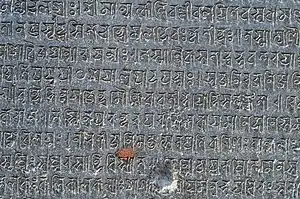 13th century temple inscription of Ananta Vasudeva Temple
13th century temple inscription of Ananta Vasudeva Temple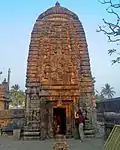 A Temple in Sri Mukhalingam temple complex
A Temple in Sri Mukhalingam temple complex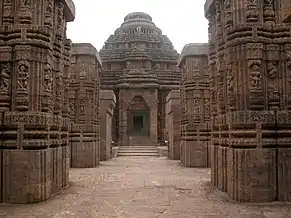 Konark Sun Temple at Konark, Odisha, built by King Narasimhadeva I (1238–1264),[22] it is now a World Heritage Site.
Konark Sun Temple at Konark, Odisha, built by King Narasimhadeva I (1238–1264),[22] it is now a World Heritage Site. A Stone carved throne at Simhachalam temple
A Stone carved throne at Simhachalam temple
See also
References
- Srichandan, G. K. (February–March 2011). "Classicism of Odia Language" (PDF). Orissa Review. p. 54. Retrieved 28 June 2019.
- Ganga Dynasty britannica.com. Archived 10 November 2007 at the Wayback Machine
- B. Hemalatha (1991). Life in medieval northern Andhra. Navrang.
- Archived 10 April 2009 at the Wayback Machine
- Patnaik, Nihar Ranjan (1 January 1997). Economic History of Orissa. Indus Publishing. p. 93. ISBN 978-81-7387-075-0. Retrieved 16 February 2015.
- B. Masthanaiah. The Temples of Mukhalingam: A Study on South Indian Temple Architecture. Cosmo Publications, 1977 - Mukhalingām (India) - 136 pages. p. 5.
- Singh, Dineshwar (1973). THE HISTORY OF THE EASTERN GANGA DYNASTY, CIRCA 1038 - 1238 A .D (PDF). London: University of London. pp. 55, 56, 57, 58.
- N. Venkata Ramanayya. Social and cultural life of the eastern Chalukyas of Vengi. [A.P.] Maulana Abul Kalam Azad Oriental Research Institute - Andhra Pradesh (India) - 96 pages. p. 83.
- Jörn Rüsen (January 2008). Time and History: The Variety of Cultures. Berghahn Books, 01-Jan-2008 - History - 262 pages. p. 72. ISBN 9780857450418.
- "Chapter VI, Setback and Recovery" (PDF). www.shodhganga.inflibnet.ac.in. pp. 238, –248. Retrieved 25 February 2020.
- Banarjee, R.D (1930). History Of Orissa Vol. 1. 120-2, Upper Circular Road, Calcutta: Prabasi Press. pp. 247, 248.CS1 maint: location (link)
- Tripat Sharma. Women in Ancient India, from 320 A.D. to C. 1200 A.D. Ess Ess Publications, 1987. p. 142.
- Kallidaikurichi Aiyah Nilakanta Sastri. History of India, Volume 1. S. Viswanathan, 1953. p. 247.
- Das, Manmatha Nath (1949). Glimpses Of Kalinga History. Calcutta: Century Publishers. pp. 164, 165, 166, 167, 168, 169, 170, 171.
- Rajaguru, Satyanarayan (1961). Inscriptions of Orissa, Volume III, Part II. Bhubaneswar: Orissa Sahitya Akademi. pp. 391, 392, 393.
- Rajaguru, Satyanarayan (1960). Inscriptions of Orissa, Volume III, Part I. Bhubaneswar: Orissa Sahitya Akademi. pp. 174, 175.
- Das, Dr. Manas Kumar (12 August 2017). "History of Odisha (From Earliest Times to 1434 A.D.)". DDCE/History (M.A)/SLM/Paper: 100, 101.
- Itihas, Volumes 19-22. p. 14.
- Andhra Historical Research Society, Rajahmundry, Madras. Journal of the Andhra Historical Society, Volumes 6-7. Andhra Historical Research Society., 1931. p. 200.CS1 maint: multiple names: authors list (link)
- Indian Research Institute. Indian Culture: Journal of the Indian Research Institute, Volume 12. I.B. Corporation, 1984. p. 159.
- Indian Research Institute. Indian Culture: Journal of the Indian Research Institute, Volume 12. I.B. Corporation, 1984. p. 160.
- Sen, Sailendra (2013). A Textbook of Medieval Indian History. Primus Books. pp. 36–37. ISBN 978-93-80607-34-4.
- Eastern Ganga Dynasty in India. India9.com (2005-06-07). Retrieved on 2013-07-12.
- Sen, Sailendra (2013). A Textbook of Medieval Indian History. Primus Books. pp. 97–100. ISBN 978-9-38060-734-4.
- Sailendra Nath Sen (1999). Ancient Indian History and Civilization. New Age International, 1999 - India - 668 pages. p. 437. ISBN 9788122411980.
- http://orissa.gov.in/portal/LIWPL/event_archive/Events_Archives/69Maharaja_Krushna_Chandra_Gajapati.pdf
- http://orissa.gov.in/e-magazine/Orissareview/2010/April/engpdf/56-57.pdf
- Orissa Review, January-2009 issue. Published by the Govt. of Orissa.
- "Meet Kalyani, first woman Gajapati of Parala royal family". The New Indian Express. Retrieved 9 October 2020.
- "Kalyani Gajapati Crowned As First Queen Of Paralakhemundi". ODISHA BYTES. 11 January 2020. Retrieved 9 October 2020.
- Ganga dynasty (Indian dynasties) - Encyclopædia Britannica. Britannica.com. Retrieved on 2013-07-12.
- Pankaj Tandon (2012), Tentative Attributions of some Gold Fanams of the Eastern Gangas, BU, retrieved 25 January 2021
- Pankaj Tandon (2018), Coins of the Eastern Gangas ruler Anantavarman Chodaganga, BU, retrieved 25 January 2021
- Michael Mitchiner (1979). Oriental Coins & Their Values : Non-Islamic States and Western Colonies A.D. 600-1979. Hawkins Publications. ISBN 978-0-904173-18-5.
